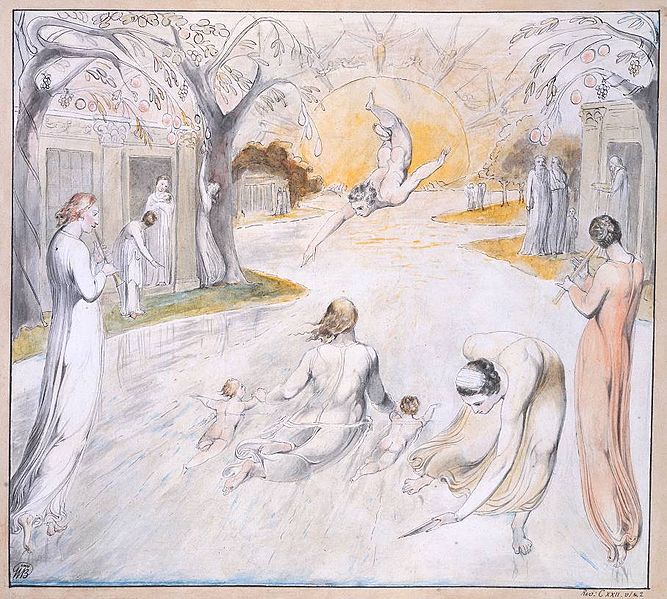In commenting on William Blake's Illustrations of the Book of Job in The Art of William Blake, Anthony Blunt wrote on page 86:
"For once he reduced his visions to terms which are readily intelligible to all, and they gained not lost in the process...
In technique the engravings are masterly. As we know from Gilchrist, Blake had refreshed his mind and his hand by a renewed study of the engravings of Marcantonio and Durer, which he loved since childhood, and his graver takes on a new subtlety and produces a great variety of effects which he had hardly ever achieved in the earlier dry manner of his master Basire. The outline remains as firm as ever, but the modelling is fuller, the effects of light more varied, the texture richer, so that the absence of color is more than made up for; and the engravings have a concentration and force lacking in the preliminary water-colours. The variety of mood is as great as in earlier works but is achieved by moderate means...Ecstasy is given its most splendid expression in the famous plate When the Morning Stars Sang Together (Plate 14).
 |
Yale Center for British Art Illustrations of the Book of Job Plate 14 |
"This last plate was Blake's final statement of a formal theme on which he had many variations and which derived ultimately from a crude engraving of a relief from Persepolis in Bryant's New system of ancient Mythology, published in 1776, the row of figures standing with their arms stretched upwards and overlapping. This device had appeared in one of the illustrations to Young's Night Thoughts, where the figures are cherubim with six wings, four of which cover their bodies and legs. The Job water-colours show four figures with one pair of wings each, clad in short skirts and flanked by two wisps of a cloud. In the engravings the group is made more coherent and more lively by the introduction of flowing gauze-like dresses which cover the figures right down to their feet and link with the line of the clouds, integrating them into the design. But Blake's most effective change at this stage is to add, at each end of the row of figures, an extra arm cut off by the edge of the plate, which suggests with striking effect that the row is continued indefinitely beyond the frame of the engraving and ads mystery to the whole conception."
Blake made at least two additional images of this motif. In his illustrations to Milton's On the Morning of Christ's Nativity he pictured five angels is a row, enclosed in a circle of angels. At the bottom of plate 22 of Jerusalem Blake contrasted the Wings of Cheribim with Iron Wheels of war. The angels once again reach out to each other with the implication that an infinite pattern continues.
"Why should Punishment Weave the Veil with Iron Wheels of War
When Forgiveness might it Weave with Wings of Cherubim" This image of interlocked angels singing their praise and gratitude was Blake's response to the following verses in the Book of Job:
Job 38
[4] Where wast thou when I laid the foundations of the earth? declare, if thou hast understanding.
[5] Who hath laid the measures thereof, if thou knowest? or who hath stretched the line upon it?
[6] Whereupon are the foundations thereof fastened? or who laid the corner stone thereof;
[7] When the morning stars sang together, and all the sons of God shouted for joy?
The words Morning Star appear also in the Book of Revelation.
Revelation 22
[16] I Jesus have sent mine angel to testify unto you these things in the churches. I am the root and the offspring of David, and the bright and morning star.
[17] And the Spirit and the bride say, Come. And let him that heareth say, Come. And let him that is athirst come. And whosoever will, let him take the water of life freely.
In the Four Zoas Urizen and his obedient sons came not. The turned away.
Four Zoas, Night III, Page 37, (E 326)
"Now sat the King of Light on high upon his starry throne
And bright Ahania bow'd herself before his splendid feet
O Urizen look on Me. like a mournful stream
I Embrace round thy knees & wet My bright hair with my tears:
Why sighs my Lord! are not the morning stars thy obedient Sons
Do they not bow their bright heads at thy voice? at thy command
Do they not fly into their stations & return their light to thee
The immortal Atmospheres are thine, there thou art seen in glory
Surrounded by the ever changing Daughters of the Light
Why wilt thou look upon futurity darkning present joy"Four Zoas, Night V, Page 64, (E 343)"I well remember for I heard the mild & holy voice
Saying O light spring up & shine & I sprang up from the deep
He gave to me a silver scepter & crownd me with a golden crown
& said Go forth & guide my Son who wanders on the ocean
I went not forth. I hid myself in black clouds of my wrath
I calld the stars around my feet in the night of councils dark
The stars threw down their spears & fled naked away
We fell. I siezd thee dark Urthona In my left hand fallingI siezd thee beauteous Luvah thou art faded like a flower"
Songs of Innocence and of Experience, Song 30, (E 18)
"O Earth O Earth return!
Arise from out the dewy grass;
Night is worn,
And the morn
Rises from the slumberous mass,
Turn away no more
Why wilt thou turn away
The starry floor
The watry shore
Is giv'n thee till the break of day."



















